A brooder inside a chicken coop is essential for keeping baby chicks warm and comfortable during their early days. This setup helps create a cozy environment, mimicking the nurturing warmth of a mother hen. It’s straightforward to set up, ensuring your chicks thrive as they grow, giving you peace of mind and a solid start for your flock.
Brooder Size Considerations for Different Breeds

When setting up a brooder for your chicks, size matters. The image shows a cozy brooder with several chicks comfortably nestled inside. This setup is crucial for their growth and well-being.
Different chicken breeds have varying space needs. For instance, bantam breeds require less space than larger breeds like Brahmas. A general rule is to provide about 0.5 square feet per chick for smaller breeds and up to 1 square foot for larger ones. This helps prevent overcrowding and stress.
Temperature is another factor. The brooder should maintain a warm environment, especially for young chicks. The heat lamp in the image suggests a controlled temperature, which is vital for their health. Make sure to monitor the temperature closely, adjusting as the chicks grow.
Lastly, consider the layout. The brooder should allow easy access to food and water. A well-organized space helps the chicks thrive and makes your job easier. Keeping these size considerations in mind will help ensure your chicks grow up healthy and happy.
Ventilation Needs in the Brooder
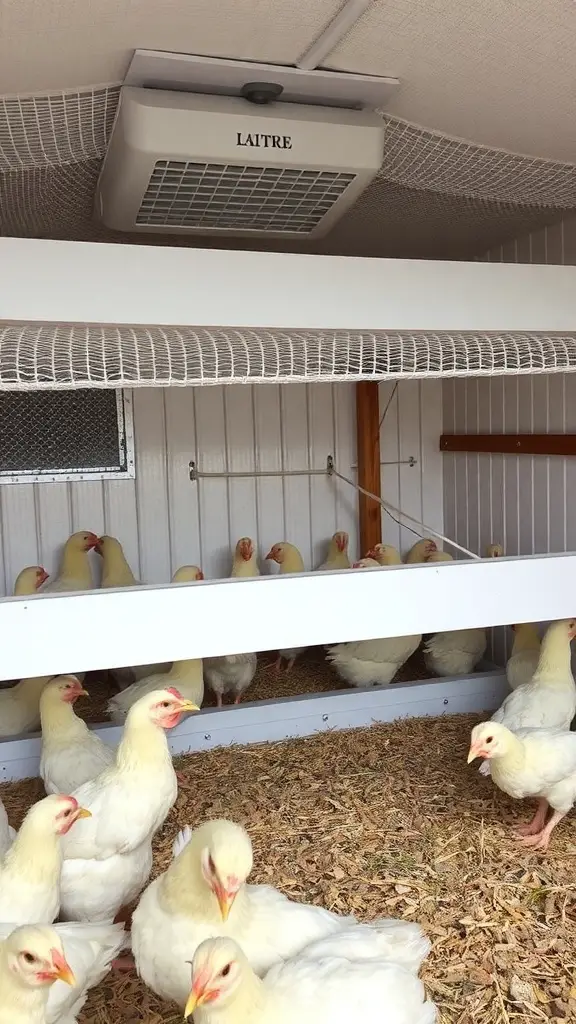
Proper ventilation in a brooder is key to keeping your chicks healthy and happy. In the image, you can see a brooder equipped with a ventilation system, which is essential for maintaining a comfortable environment.
Chicks produce a lot of heat and moisture, especially when they are young. Without good airflow, the brooder can become stuffy and humid. This can lead to respiratory issues and other health problems for the chicks.
The fan shown in the image helps circulate air, ensuring that fresh air comes in while stale air is pushed out. This balance is crucial for preventing the buildup of ammonia from droppings, which can be harmful.
It’s also important to monitor the temperature inside the brooder. Too much ventilation can lead to drafts, which can chill the chicks. Finding the right balance is key to their well-being.
In summary, a well-ventilated brooder not only keeps your chicks comfortable but also promotes their overall health. Investing in a good ventilation system is a smart move for any chicken keeper.
Feeding and Watering Solutions for Chicks

In the image, we see a lively group of chicks in a cozy brooder. They are surrounded by soft bedding, which keeps them comfortable and warm. On the shelf above, there are several feeders, each with a red lid, ready to provide the chicks with nutritious food.
Feeding your chicks is a key part of raising healthy birds. Start with a high-quality chick starter feed. This feed is specially formulated to give them the right nutrients for growth. Make sure to refill the feeders regularly so that the chicks always have access to food.
Water is just as important. In the image, there’s a waterer designed for easy access. It’s crucial to keep the water clean and fresh. Chicks can be messy, so check their water supply often. You want to make sure they stay hydrated, especially in warmer conditions.
Setting up a good feeding and watering system will help your chicks thrive. Keep an eye on their eating and drinking habits. If you notice any changes, it might be time to adjust their diet or check their health.
Monitoring Chick Behavior in the Brooder
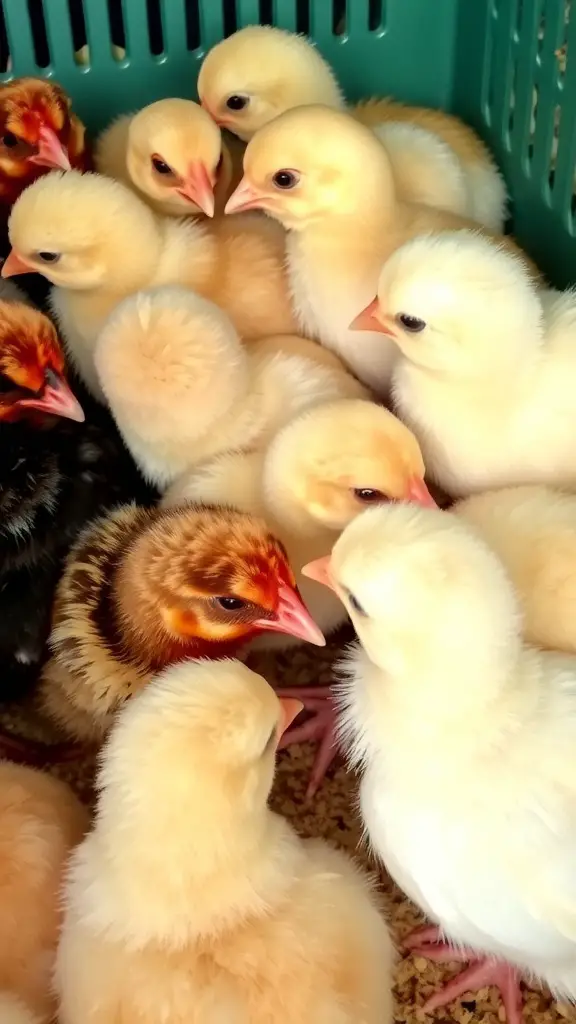
In the cozy confines of a chicken coop, the brooder is a special space for young chicks. This image captures a lively group of chicks, all huddled together, showcasing their natural behaviors. Observing them can be quite entertaining and informative.
Chicks often display various behaviors that indicate their comfort and health. For instance, when they are relaxed, you might see them fluffing their feathers or gently pecking at each other. This is a sign that they feel safe in their environment. On the other hand, if they seem overly clustered or are chirping loudly, it could mean they are feeling stressed or cold.
It’s essential to keep an eye on their interactions. Watching how they establish pecking order can be fascinating. Some chicks will assert themselves, while others may be more timid. This social dynamic is crucial for their development.
Providing ample space, warmth, and proper nutrition will help ensure that these little ones thrive. Regular monitoring will give you insights into their needs and help you create a nurturing environment.
Temperature Management in the Brooder
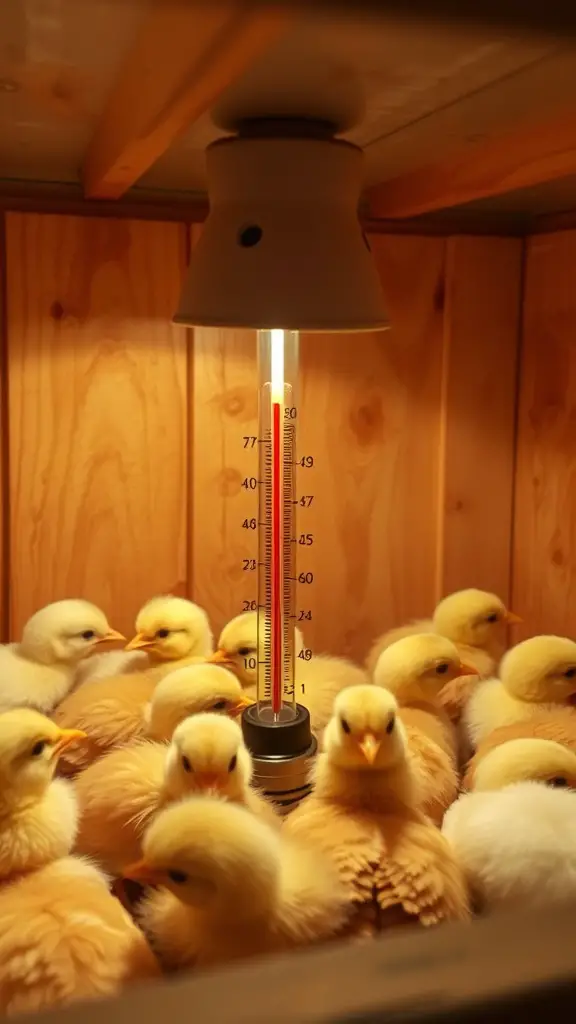
Managing temperature in the brooder is key for the health and growth of your chicks. In the image, you can see a group of fluffy chicks gathered around a thermometer and heat source. This setup is essential for keeping them warm and comfortable.
Chicks need a specific temperature range to thrive. When they are just hatched, they require a cozy 90-95°F (32-35°C). The thermometer in the image helps monitor this crucial temperature. As the chicks grow, you can gradually lower the temperature by about 5°F each week.
The heat source, often a heat lamp, provides the warmth they need. It’s important to place it at the right height to avoid overheating. If the chicks huddle together, they might be too cold. If they spread out away from the heat, they might be too hot. Observing their behavior is a great way to adjust the temperature accordingly.
Keeping the brooder at the right temperature not only ensures the chicks are comfortable but also promotes healthy development. A well-managed brooder sets the stage for a happy flock!
Selecting the Best Brooder Design
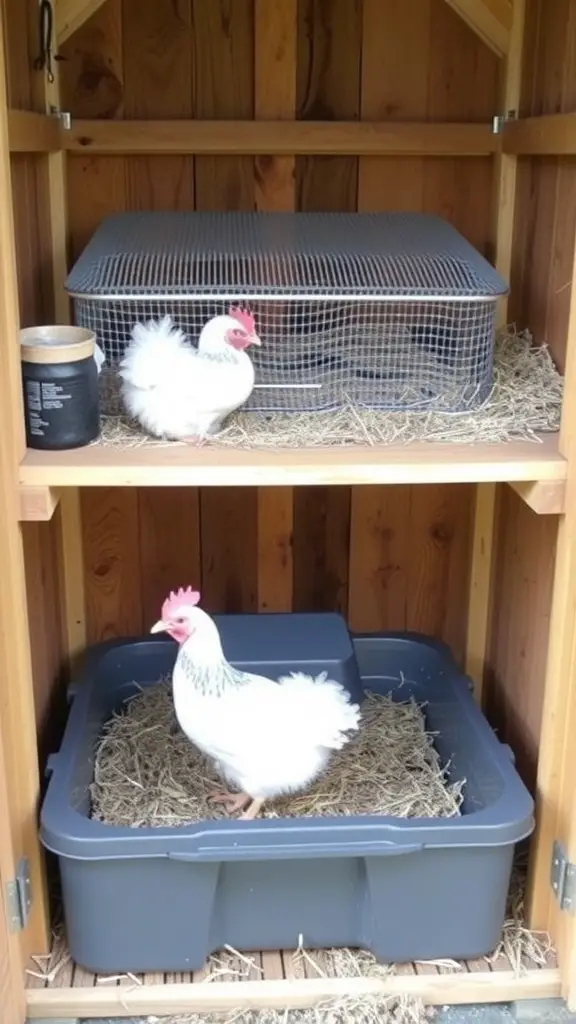
When it comes to raising chicks, having the right brooder is key. The image shows a cozy setup inside a chicken coop, featuring various brooder designs. Each design serves a unique purpose, making it easier to care for your young birds.
The brooder on the left has a sturdy frame and mesh sides, allowing for good ventilation. This is important to keep the chicks comfortable and healthy. The wooden structure beside it offers a solid base for feeding and resting.
Don’t overlook the importance of space. Chicks need room to move around, so choosing a brooder that fits well in your coop is essential. The layout in the image shows a thoughtful arrangement, maximizing space while ensuring safety.
Lighting also plays a role in your brooder design. A light source can be seen above, providing warmth. Chicks require a warm environment, especially in their early days. This setup seems to provide that necessary heat.
Lastly, consider ease of cleaning. The materials used in these designs appear easy to wipe down, which is a plus for maintaining hygiene. A clean brooder helps prevent diseases and keeps your chicks thriving.
Bedding Options for the Brooder
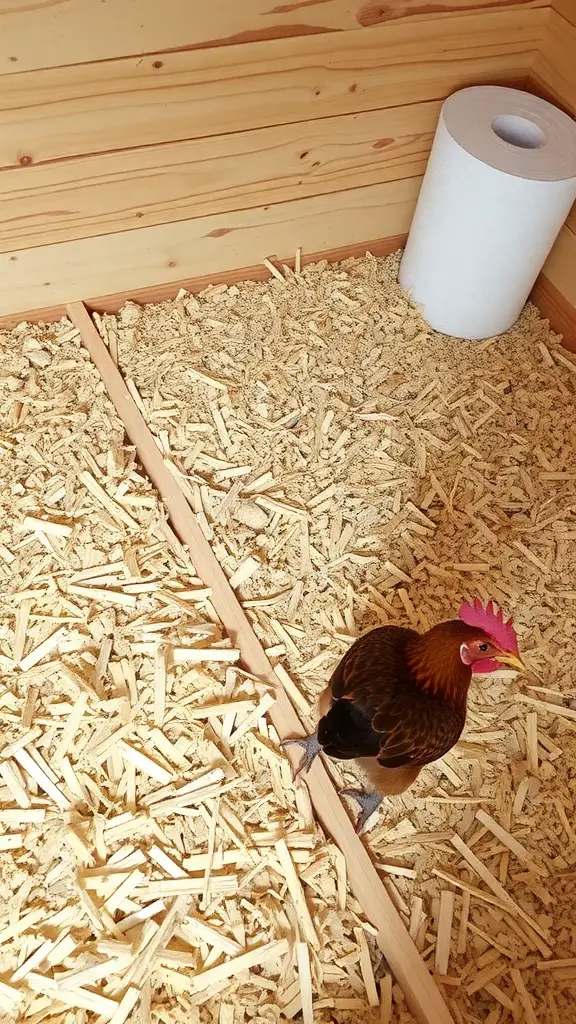
Choosing the right bedding for your brooder is key to keeping your chicks comfortable and healthy. In the image, you can see a cozy setup with wood shavings covering the floor. This type of bedding is popular because it’s absorbent and helps control odors.
Wood shavings are soft and provide a nice cushion for the chicks. They can scratch around and play, which is great for their development. Another option is straw, which can also be used, but it tends to be less absorbent than shavings.
Paper towels are visible in the image, and they can be a good choice for the first few days. They provide a clean surface and make it easy to monitor the chicks’ droppings. Just remember to switch to something more absorbent as they grow.
Whichever bedding you choose, make sure to keep it clean and dry. Regular changes will help keep your chicks happy and healthy!
Choosing the Right Location for the Brooder
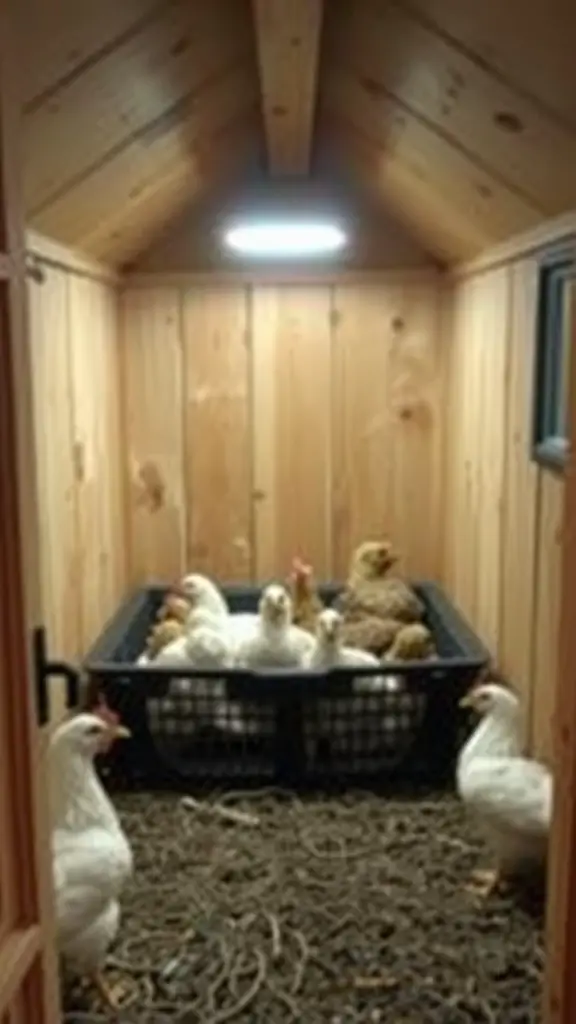
Setting up a brooder is a key step in raising healthy chicks. The image shows a cozy brooder inside a chicken coop, where several chicks are comfortably gathered. This space is designed to keep them warm and safe as they grow.
When choosing a location for your brooder, think about warmth and safety. It’s important to place it in a spot that stays warm, especially during colder months. A well-insulated area helps maintain the right temperature for the chicks.
Light is another factor. The coop in the image has a light source, which is great for providing extra warmth and visibility. Make sure your brooder has adequate lighting to help the chicks feel secure and encourage their natural behaviors.
Ventilation is also key. The coop should have good airflow to prevent moisture buildup, which can lead to health issues. Ensure that the area is not too drafty, as chicks can be sensitive to cold drafts.
Lastly, consider the layout. The brooder should be easy to access for feeding and cleaning. Keeping it tidy is essential for the health of your chicks. A well-organized space will make your brooding experience smoother and more enjoyable.
Introducing Chicks to the Brooder
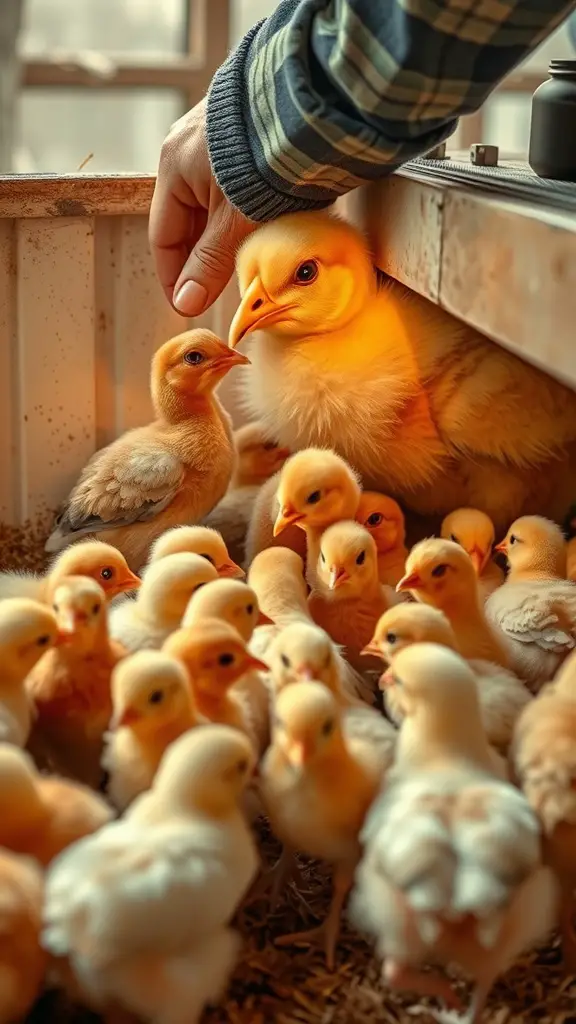
Bringing chicks into the brooder is an exciting time for any chicken keeper. The image shows a cozy brooder filled with fluffy chicks, all gathered around a gentle hand. This moment captures the warmth and care that goes into raising these little birds.
When you first introduce chicks to the brooder, it’s essential to make sure the environment is just right. The temperature should be warm enough to keep them comfortable, usually around 95°F for the first week. Gradually, you can lower it as they grow.
Chicks are naturally curious, and they will explore their new space. It’s a good idea to have food and water readily available. The image highlights how a caring hand can help guide them, ensuring they find their way to the food and water sources.
As they settle in, you’ll notice their personalities start to shine. Some will be more adventurous, while others may prefer to stay close to their siblings. This bonding time is crucial for their development and helps them feel secure in their new home.
Transitioning Chicks from Brooder to Coop
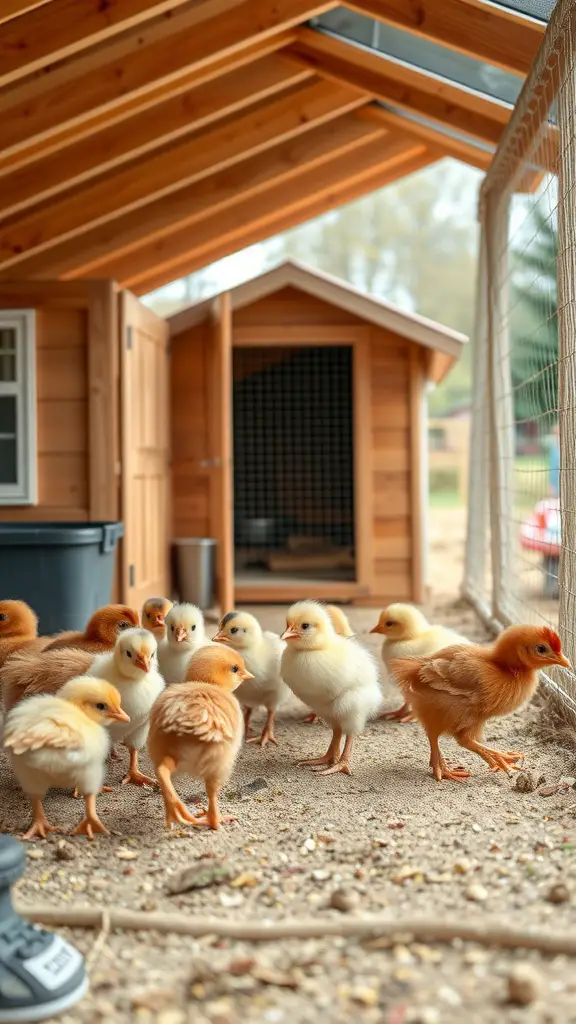
Moving chicks from the brooder to the coop is an exciting step in their growth. In the image, you can see a cozy chicken coop with a group of fluffy chicks exploring their new surroundings. They look curious and ready to take on the world outside the brooder.
When the time comes to transition, it’s essential to ensure the chicks are at least 4-6 weeks old. This age allows them to handle the cooler temperatures outside. The coop should be clean, secure, and free from drafts to keep them safe and comfortable.
As you introduce them to the coop, make sure they have access to food and water. It’s a good idea to keep the brooder nearby for a few days, so they can return if they feel scared. The chicks will gradually learn to explore their new home, scratching and pecking around.
Watch them closely during the first few days. If they seem stressed, you can always bring them back to the brooder for a little longer. This transition is all about helping them feel secure in their new environment.
Safety Precautions for Brooder Setup
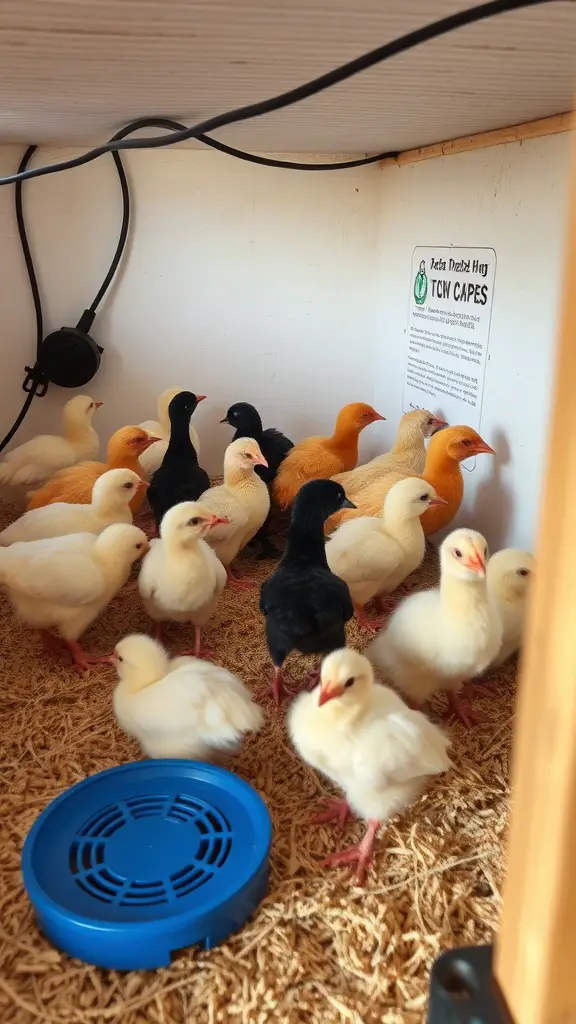
Setting up a brooder inside your chicken coop is an exciting step in raising chicks. In the image, you can see a cozy space filled with fluffy chicks of various colors. They seem curious and lively, exploring their new environment. It’s important to create a safe and comfortable area for them to thrive.
First, ensure the brooder is clean and free from any harmful substances. Use fresh bedding, like straw or wood shavings, to provide a soft surface for the chicks. This helps prevent injuries and keeps them warm.
Next, check the heat source. Chicks need a warm environment, usually around 90-95°F for the first week. Use a heat lamp, but make sure it’s securely fastened to avoid any accidents. Keep the lamp at a safe distance to prevent overheating.
Ventilation is also key. Ensure there’s enough airflow without creating drafts. Good ventilation helps maintain a healthy environment and reduces the risk of respiratory issues.
Lastly, monitor the chicks regularly. Look for signs of distress or illness. Keeping a close eye on them helps you address any issues quickly, ensuring they grow up healthy and strong.
Signs of Stress in Chicks Inside the Brooder
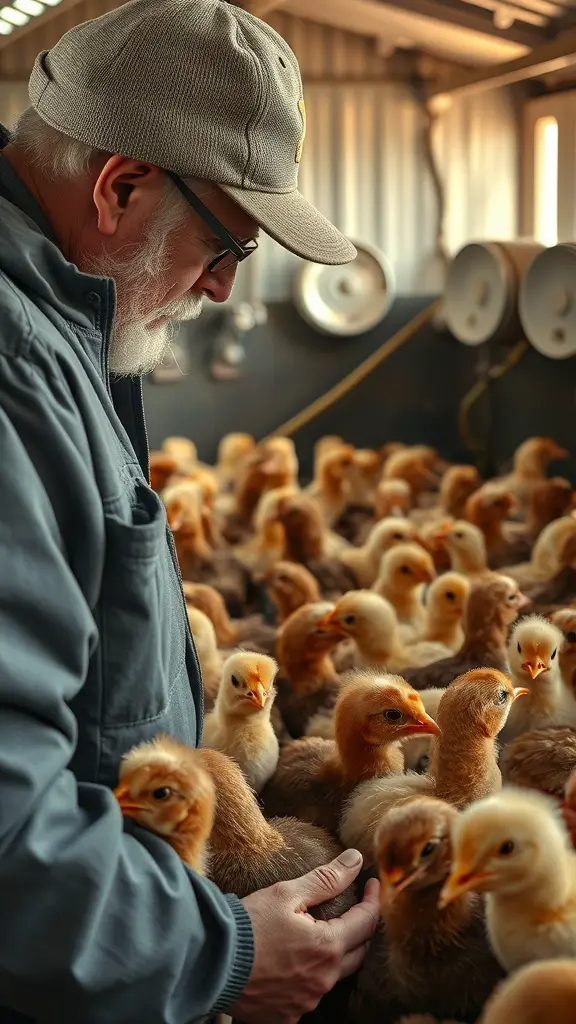
When you look at a brooder filled with chicks, it’s easy to get lost in their cuteness. However, keeping an eye on their behavior is crucial. Stress in chicks can show up in various ways, and recognizing these signs early can help you ensure their well-being.
In the image, we see a person gently interacting with a group of chicks. This kind of calm handling can help reduce stress. If chicks are huddling together or avoiding interaction, it might indicate they are feeling anxious. A healthy brooder environment should encourage them to explore and interact.
Another sign of stress is excessive peeping. While some noise is normal, constant loud peeping can mean they are uncomfortable. Check the temperature and make sure they have enough space to move around. Overcrowding can lead to stress, so it’s vital to provide ample room for each chick.
Lastly, watch for signs of lethargy. If a chick is sitting alone and not moving much, it could be a sign of stress or illness. Keeping the brooder clean and ensuring they have access to fresh water and food can help maintain their health. By being attentive to these signs, you can create a happier, healthier environment for your chicks.
Maintaining Cleanliness in the Brooder
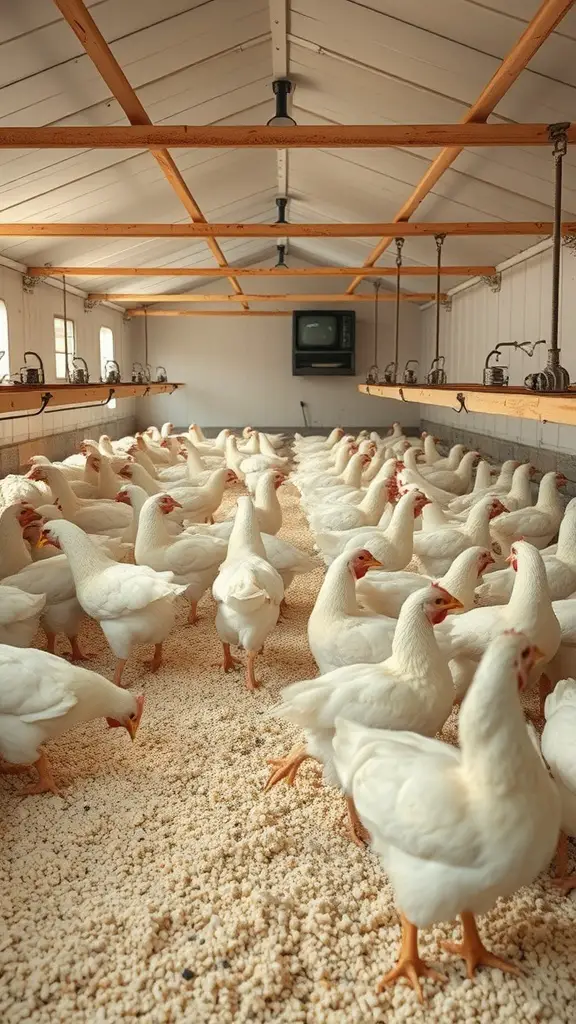
Keeping the brooder clean is key to raising healthy chicks. In the image, you can see a spacious chicken coop filled with white chickens. The floor is covered with bedding, which helps absorb moisture and control odors. Regularly changing this bedding is essential to prevent the buildup of waste.
Daily checks for any signs of dirt or droppings can make a big difference. Spot cleaning areas where the chicks spend most of their time helps maintain a hygienic environment. It’s also a good idea to ensure that food and water containers are clean and free from spills.
Ventilation is another important aspect. Good airflow helps reduce humidity and keeps the air fresh. In the image, you can spot fans that help circulate air, which is great for keeping the chicks comfortable and healthy.
Lastly, always wash your hands after handling the chicks or cleaning the brooder. This simple step prevents the spread of germs and keeps both you and your chickens safe.


